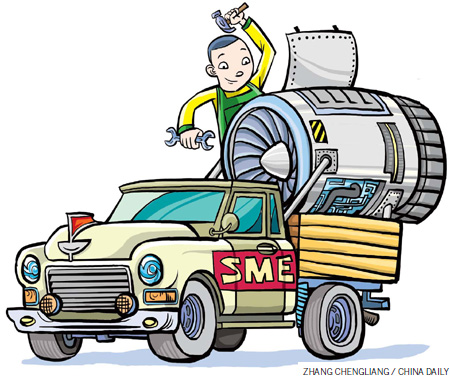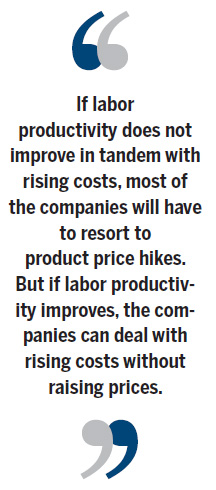Economy
SMEs need right tools to rein in costs
Updated: 2011-07-08 12:14
By Xu Qiyuan (China Daily European Weekly)
|
 |
Businesses should tinker with strategies to combat rising raw material prices
Small- and medium-sized enterprises (SMEs) in China must upgrade their technologies and transform themselves to cope with intense competition and rising labor and raw material costs.
The rising costs are worrisome as there has been no slowdown in the inflation. The consumer price index, the main gauge of inflation, rose to 5.5 percent in May, and when the figures for June are released later this month, they are expected to log another increase.
The Producer Price Index, which reflects changes in the prices of raw materials and other costs, came in at 6.8 percent in May, down from 7.3 percent in March, but still much higher than in September, when it was 4.3 percent.
What's more, the rising yuan has also compounded problems for SMEs. The yuan rose to a new high of 6.4696 against the US dollar on June 20, a 5.24 percent growth from a year earlier. Prior to June 19 last year the US dollar was valued at around 6.8275 yuan. The significant yuan appreciation has now added to the cost worries for exporters.
But it is the rising labor costs that is the most crucial and one that needs immediate fixes.
Yiwu in Zhejiang province is a noted wholesale market for small commodities. But due to the rising costs, the net profit of the city is expected to decrease by 17.5 billion yuan (1.86 billion euros) this year. The strongest blow is expected to come from rising labor costs, which alone may bleed the net profits of the city to the tune of 9 billion yuan.
If labor productivity does not improve in tandem with rising costs, most of the companies will have to resort to product price hikes. But if labor productivity improves, the companies can deal with rising costs without raising prices.
In spite of the gloom the situation is still optimistic. Many companies have taken several measures to cope with rising labor costs.
Investing in new technology seems to be the most popular method among companies to improve labor productivity. A pen-making company in Zhejiang has, for instance, introduced a new assembly line to replace its manual production mode, a measure that resulted in production efficiency going up tenfold. The company successfully reduced the number of employees and improved its labor productivity.
Some companies have earmarked more funds for technology research and development either by themselves or in partnership with other companies. The companies, which want to develop the technologies themselves, are fairly rich in capital and have special requirements for technology upgradation, thereby indicating the need for such moves.
An accessory maker in Zhejiang has, for instance, joined hands with two universities in the region for new production technologies. By adopting these new techniques, the company has shortened its production cycle from one week to two days, and reduced the number of employees by nearly 20 percent.
The staff reduction has also improved the company's wage bill and bolstered finances. Currently, the company is making more efforts in furthering more research and development projects that will cut costs further.
|
|
Diversifying operations is another technique adopted by companies to reduce costs. Many SMEs have started to develop new products or move into other industries to diversify risk. SME entrepreneurs have in recent times been investing in the real estate sector due to its high profitability. But such diversification is also fraught with problems due to the inherent risks of real estate investments and also as it dampens the initiative of the companies to undertake upgrades.
Overseas mergers and acquisitions (M&A) is also one of the avenues being pursued by the companies to bypass trade barriers and discriminatory policies. Such M&As will help the companies to establish their brands and gain valuable overseas management experience.
Yet another option for SMEs to stave off rising labor costs is to move their production bases to the hinterland. Many companies have shifted part of their production to other places in Zhejiang province, while some have moved to the central or western China. Some of them have outsourced the production process to other companies, which has largely reduced labor costs.
The SMEs that have well-operated businesses and good financial performances have the strongest desire to upgrade. But they are also faced with many challenges during the process of transformation.
First, they need to get adequate funding to conduct R&D. But currently, the authorities have curbed lending and money supply to combat inflation, a move that has further increased the pressure on China's capital-thirsty small businesses.
What's more, due to the huge investment in fixed assets, it may take a long time for the companies to realize returns on their R&D investment. This in turn could compound cash flow problems for the companies.
The author is an associate researcher with the Institute of World Economics & Politics at the Chinese Academy of Social Sciences.

Specials

90th anniversary of the CPC
The Party has been leading the country and people to prosperity.

My China story
Foreign readers are invited to share your China stories.

Green makeover
Cleanup of Xi'an wasteland pays off for ancient city
